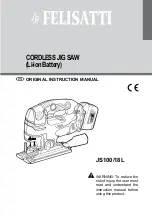
7 ENGLISH
ASSEMBLY
CAUTION:
•
Always be sure that the tool is switched off and
unplugged before carrying out any work on the
tool.
Installing or removing saw blade
CAUTION:
•
Always clean out all chips or foreign matter
adhering to the blade and/or blade holder.
Failure to do so may cause insufficient tighten
-
ing of the blade, resulting in serious personal
injury.
•
Do not touch the blade or the workpiece imme
-
diately after operation as they may be extremely
hot and could cause burn injury.
•
Always secure the blade firmly. Insufficient tight
-
ening of the blade may cause blade breakage or
serious personal injury.
►
Fig.2:
1.
Hex socket head bolt
2.
Hex wrench
To install the blade, loosen the bolt counterclockwise on
the blade holder with the hex wrench.
With the blade teeth facing forward, insert the blade into
the blade holder as far as it will go. Make sure that the
back edge of the blade fits into the roller. Then tighten
the bolt clockwise to secure the blade.
To remove the blade, follow the installation procedure
in reverse.
Adjusting roller
►
Fig.3:
1.
Hex wrench
2.
Hex bolt
►
Fig.4:
1.
Roller
2.
Saw blade
Loosen the hex bolt on the back of the base with
the hex wrench. Move the retainer so that the roller
contacts the blade lightly. Then tighten the hex bolt to
secure the base and the retainer.
However, when using the blade that does not have a
straight back, slide the retainer back so that the roller
will not contact the blade.
NOTE:
•
Occasionally lubricate the roller.
Hex wrench storage
►
Fig.5:
1.
Hex wrench
When not in use, the hex wrench can be conveniently
stored.
OPERATION
CAUTION:
•
Hold the tool firmly with one hand on the main
handle when using the tool. If necessary, the
front part of the tool may be supported by the
other hand.
•
Always hold the base flush with the workpiece.
Failure to do so may cause blade breakage,
resulting in serious injury.
•
Advance the tool very slowly when cutting
curves or scrolling. Forcing the tool may cause a
slanted cutting surface and blade breakage.
►
Fig.6
Turn the tool on without the blade making any contact
and wait until the blade attains full speed. Then rest
the base flat on the workpiece and gently move the tool
forward along the previously marked cutting line.
Bevel cutting
CAUTION:
•
Always be sure that the tool is switched off and
unplugged before tilting the base.
►
Fig.7
With the base tilted, you can make bevel cuts at any
angle between 0° and 45° (left or right).
►
Fig.8:
1.
Hex wrench
2.
Hex bolt
Loosen the bolt on the back of the base with the hex
wrench and slide the base backwards.
►
Fig.9:
1.
Edge of housing
2.
Graduation
Tilt the base until the desired bevel angle is obtained.
The edge of the housing indicates the bevel angle by
graduations. Then check the contact between the back
edge of the blade and the roller. Now tighten the bolt to
secure the base.
Front flush cuts
►
Fig.10:
1.
Hex wrench
2.
Hex bolt
Loosen the bolt on the back of the base with the hex
wrench and slide the base all the way back. Then
tighten the bolt to secure the base.








































